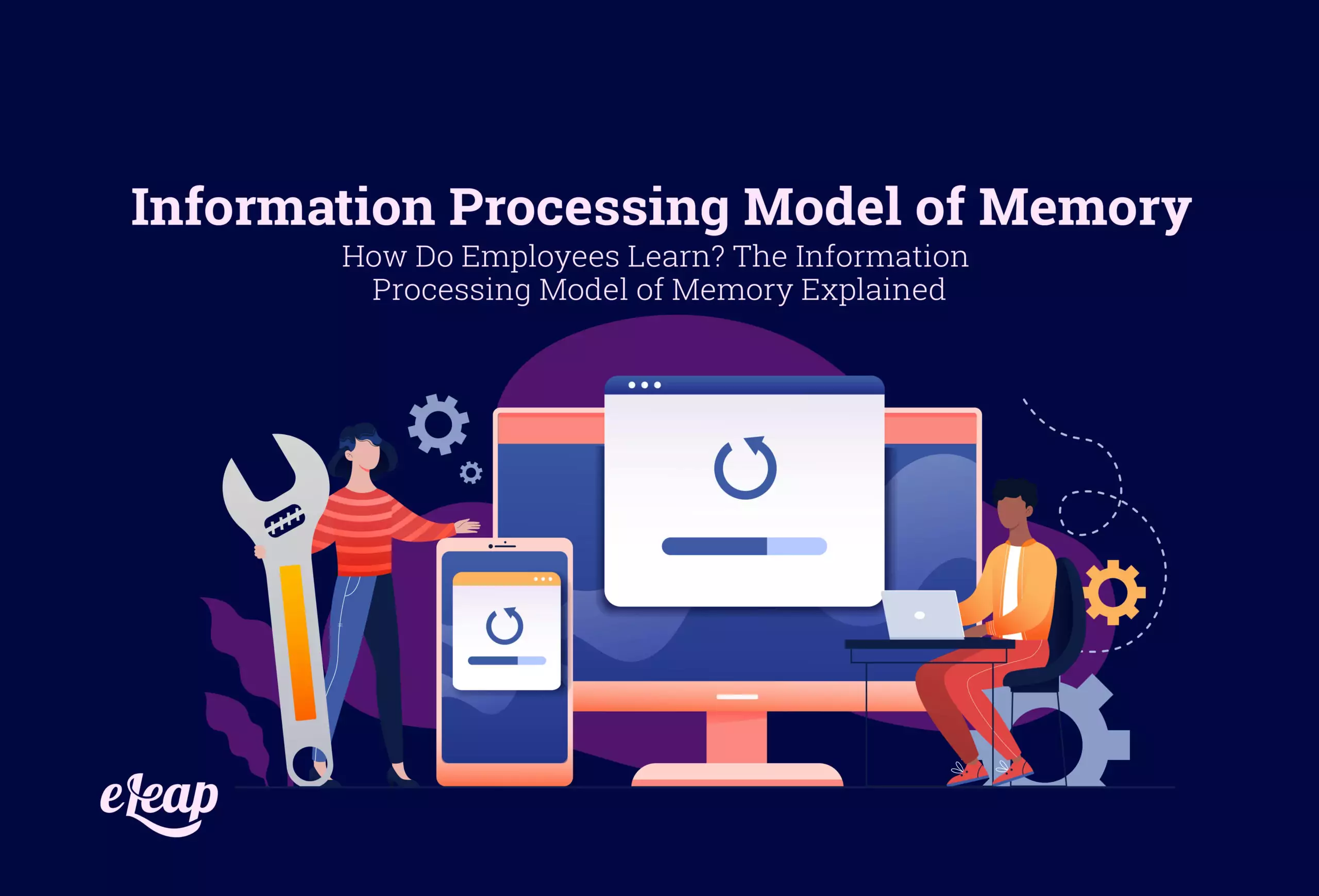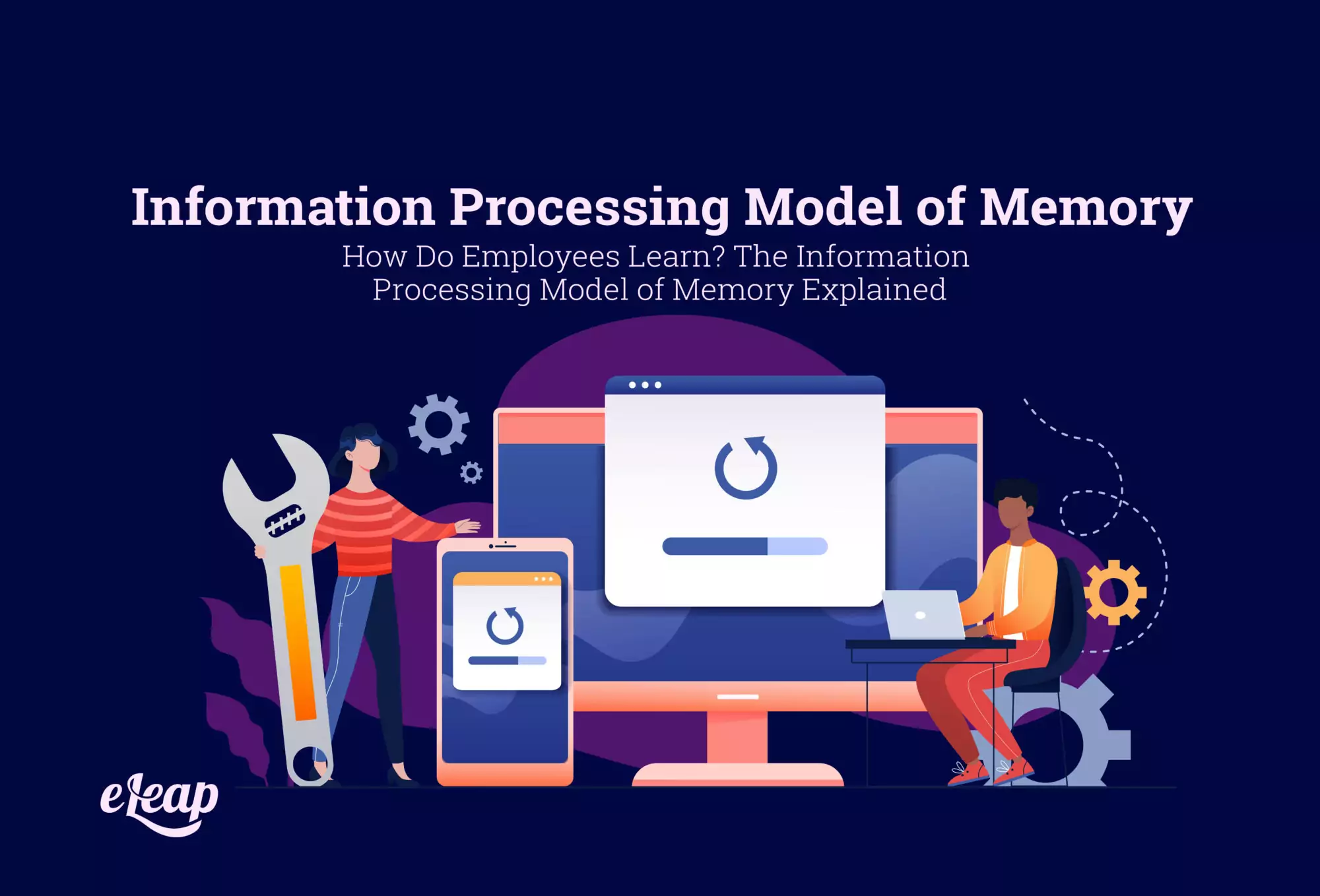Information Processing Model of Memory
How Do Employees Learn? The Information Processing Model of Memory Explained

When you are designing the training program for your team members, one of the things you’ll probably consider is how to ensure that information is retained. It’s one thing for learners to grasp a concept in the moment, but the best education happens when a deep, lasting understanding is encouraged. Understanding the information process model of memory will help you assess your training for this longevity.

What is the Information Processing Model of Memory?
Memories happen in the brain in two stages: first, short-term memory is created. Then, short-term memory is converted into long-term memory if the brain decides this is information worth retaining. The information processing model of memory is a psychological theory from the 1950s that helps us better understand how this process works.
The theory says to treat the brain like a computer:
- First, we feed the “computer” information. This means some kind of sensory input for humans, such as reading a manual or hearing instructions.
- Next, short-term memory is stored, and our brain begins to sort through this information to decide what is essential.
- Anything deemed necessary is then put into the “hard drive” – or the long-term memory.
You can use your understanding of this process to help your trainees retain the valuable information you have to offer.
Step One: The Senses and the Information Processing Model of Memory
The first step above is to feed the brain the information. But wait – if we know that the brain will be making decisions about what is and isn’t essential to save, can we design our materials so that the information is prioritized for long-term saving?
Absolutely. The best way to ensure that your training information is stored in long-term memory is to stimulate multiple senses.
When the brain is receiving information from many senses, that information gets flagged as critical. It’s why we can easily tune out a radio but have a more challenging time ignoring a movie in a movie theater – more senses are being engaged.
Present your information by using different stimuli. Combine an audio presentation with infographics and end the session with a hands-on project. This engages people’s echoic memory through the ears, iconic memories through the eyes and kinetic memory through the hands.
This also helps appeal to the strengths of many people in the training sessions, which only enhances how well they retain knowledge.
Step Two: Everything Processes in the Working Memory
The next part of the information processing model of memory is short-term or working memory. Once all that information has been gathered, the brain will begin sorting through it all. Working memory is where people store things they’ll need for quick tests at the end of a course. If you’ve ever aced a pop quiz but forgotten everything the instructor said weeks later, it’s likely that the information never made it out of your short-term memory.
Many things impact how the brain chooses what to send to the long-term memory, such as:
- How does the person feel on the day of the training? Are they focused that day, or do they feel scattered?
- How much of a person’s attention are they choosing to give to the topic?
- Is the training being tailored to a person’s best learning style?
The best thing that a trainer can do is to ensure that the information is presented in an engaging way to capture attention. Be sure to offer multiple methods of learning to engage each trainee.
Repetition is another crucial factor for transferring information from working memory to long-term memory. Repeat projects in the field or offer different materials that cover the same skills.
Step Three: Keeping the Information in the Long-Term Memory
The final step in the information processing model of memory is keeping what you’ve learned in your long-term memory. Just because information gets sent to your “hard drive” doesn’t mean that it will stay there forever. In fact, it is expected that some data will be lost over time. The brain can only hold so much information for long periods of time and will regularly “delete” some things in order to store new information.
To help your employees maintain an in-depth understanding of what you teach, you can use several strategies.
- Offer the information in digestible chunks. Allow trainees to store small pieces of information first so they don’t become overwhelmed trying to save too much in the long-term memory.
- Be sure to give the information presented plenty of relatable context. Answer any “why” questions a trainee has. This helps the brain associate the information with other information it already has, which aids in long-term retention.
- Make the information very meaningful to employees. Show them where the new skill or knowledge will come into play in the day-to-day activities they perform. Giving information a purpose makes it more likely the brain will choose to hang on to it.
- Finally, don’t forget about that repetition! It is the easiest way to encode new information directly into long-term memory. In your training, you can provide repetition with written assignments, verbally, visually, and with repeated projects to engage all the senses.
The Information Processing Model of Memory in Your Office
The human mind does have its limits and can’t be expected to be as fast or as efficient as an actual computer. A person’s physical and emotional state can impact their mental abilities in ways that computers could never experience. But humans also have abilities that computers do not, such as processing information within broader contexts that are too difficult to put into code or digesting information from multiple channels at once within various contexts.
With that in mind, using the information processing model of memory theory to design your training methods is a fantastic way to help employees gain an expert-level understanding of topics. Your team will have long-term knowledge to build upon, the context for why this information is so important, and improved skills for the future.